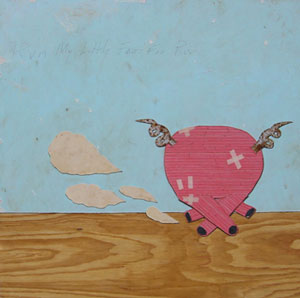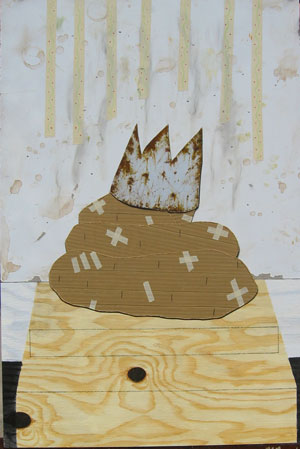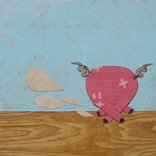Recently represented in two San Antonio exhibitions, Blue Star’s Mexican Report during the summer and Triangle Project Space’s Oil…
Recently represented in two San Antonio exhibitions, Blue Star’s Mexican Report during the summer and Triangle Project Space’s Oil, which closed this past December, Luis Miguel Suro was one of the leading emerging artists from Mexico. In an unfathomable tragedy, Suro was shot and killed December 17th during an armed robbery at his family’s ceramic factory in Guadalajara.
As evidence of his burgeoning talent, Suro was honored with the Omnilife Grand Prize for sculpture in Guadalajara in 2000, and the same year received a grant for emerging artists from the Fondo Nacional para la Cultura y las Artes in Mexico City. During the past few years, he was also awarded with residencies from the Braziers International Artist Workshop in Oxfordshire, the École Cantonale d’Art du Valais, Sierre, in Switzerland, and the Art Omi International Artists’ Colony in Omi, New York.
Suro studied drawing in Guadalajara, painting and art theory at the Instituto Cultural Cabañas, and architecture at the Instituto Tecnológico de Estudios Superiores de Occidente (ITESO) in 1990-91. He also took part in workshops in contemporary art theory at Corpus Callosum in El Callo and the Fundación de Arte Contemporáneo (FARCO) in 1994 and 1998. In addition to his formal training was his experience in the commercial ceramics industry, which in part had a more formidable impact on his ideas and practice.
Suro lived and worked in Guadalajara, and grew up in the small town of Tlaquepaque (now considered a suburb of Guadalajara). Since the 1950s, the area has developed as one of the major producers of Mexican decorative objects. Known mostly for ceramics and blown glass, Tlaquepaque also produces metal handicrafts, textiles and stone work all rendered in a “Mexican” aesthetic — a style fusing Pre-Columbian, Spanish Colonial, post-colonial and ranch aesthetics. Complexities of this constructed and inherited aesthetic find themselves in Suro’s work, both conceptually and formally.
The artist’s father, Noé Suro, is one of the leading industrial ceramic producers of the region, and had a c onsiderable effect on his son’s output. Suro’s art, whether ceramic or video, is founded in his experiences growing up around a factory that produces iconic objets d’art that are charged with materializing a Mexican identity. This relationship has, as critic Cynthia Nadelman observed, “given Suro a heightened sensitivity toward the clashes and the connections between craft and the sleekly anonymous, mass-produced products of today.” [1]
Throughout his work this tension arose, as in his exhibition Daily Plagiarism (2000), which included ceramic sculptures of random, overlooked, mass-produced objects of the everyday — throat lozenges, buttons, pens — inflated in scale and presenting themselves as something unique. In his series of the same year Pull the Button, Suro reimagined a computer keyboard as individual ceramic keys, with new keywords playing upon the technologies’ own jargon (and the human culture dependant upon it) with such terms as POWER, CANCEL, MUTE, TALK, PANIC. A culmination of those words, somewhat, is manifested in an earlier series of ceramic pieces titled Assassination — Suicide Pistol (1997), a series of colorful ceramic pistols detailed with pre-Columbian patterns, with an extra-long barrel that aims simultaneously in opposing directions. If functional, the pistols kill both the shooter and the victim, a classic Suro twist made poignantly ironic in the wake of his death.
Lingering in Suro’s work are bold, honest, and insightful statements of human and cultural relationships, all rendered with quiet, keen precision. In one of San Antonio’s strongest shows from 2004, Suro demonstrated his personal history and his wit through a series of flower paintings and police shields. The group exhibition, OIL, at the Triangle Project Space, was curated by artist/curator Christián Silva and included Silva, Suro and four other leading artists based in Guadalajara: Jose Dávila, Gonzalo Lebrija, Fernando Palomar, and Eduardo Sarabia. For their Texas exhibition, Silva chose the word “oil” as a point of reference for the artists, as opposed to being the common denominator for the grouping. ‘Oil’ is a word “which in Spanish could be translated as ‘oleo,’ aceite,’ ‘grasa,’ ‘crisma,’ ‘lubricante,’ or ‘petroleo,’”[2] and the exhibition addressed a range of issues, including power, fragility, myth, neglect, barriers, and production.
In this show, Suro examined the precarious balance of power and fragility in Police Shields 2, (2004). The piece featured a pair of shields, perfect replicas, rendered in white Styrofoam and signaling, inherent authority, and protection; yet the shield itself, a barrier between us and them, fails as a fake. The sign of authority, rendered in weightless, brittle material, subverts its power and only underscores its significance — an appearance of protection.
In addition to Suro’s piece, two others from Oil were noteworthy: Tarred and Feathered Bush, (2004) and Noche Americana, (2004) by Christián Silva and Gonzalo Lebrijo, respectively. In Silva’s piece, the proverbial “burning bush” didn’t have a chance to burn biblically or politically, as it stood trapped in a block of cement, tarred and feathered with black oil and soft, white feathers. Lebrijo’s piece involved a slowed-down clip from Giant, the epic film of Texas. The scene is the moment Jett Rink (James Dean) strikes black gold from his one and only oil well. This short, pivotal moment from the four-hour movie was isolated and projected inside an (overbuilt) corrugated tin shed. Lebrija slowed down the speed of the clip, making every movement, gesture, and oil splatter more traumatic, as oil begins to coat Rink and color him black.)
Following the aesthetic and conceptual practice of Suro’s ceramic works, Flowers Painting Project (2004) involved a collaboration between Suro and Rodolfo Rivera of Cerámica Suro, the family business, who generated ceramic versions of the floral patterns on the canvases. The designs are derived from Diego Rivera’s registry, which, manifest in Suro’s paintings, range from the formal tradition of the region to “free-style variations.”[3] In line with the ongoing dialogue in Suro’s work between the high and low, the unique and mass-produced, the kitsch and fine, these paintings depart from the lineage of western flower paintings, while addressing its history in the guise of nature morte. Within that tradition, the paintings are more than just a postmodern visual commentary — they speak to the whole language of flowers, from their regional incantation to the expectations invested in them.
In thinking about what kind of flowers should be used for an arrangement (we wanted to send flowers in memorium), I was led to the tragic irony of sending flowers in Luis Miguel’s memory. The sentimentality, the condolences, the love — the language of flowers — to be communicated through their presence was already taken by Suro himself. What is needed is a nature morte in Suro’s own language.
1. Cynthia Nadelman, “Dynamic Ceramics,” ArtNews (April 2001):100.
Images courtesy the artist and Triangle Project Space.
Jennifer Davy is a writer, curator, and teaches art history at UTSA living in San Antonio.






